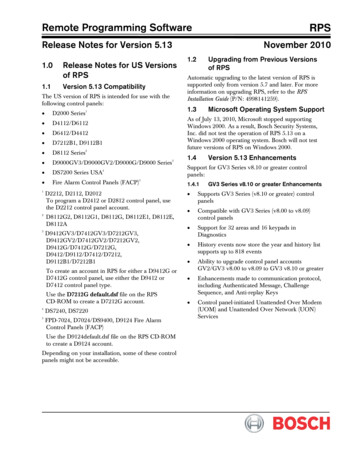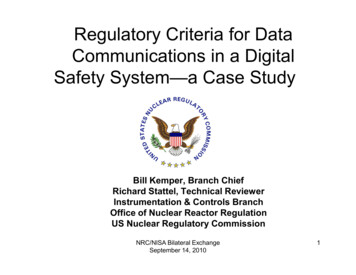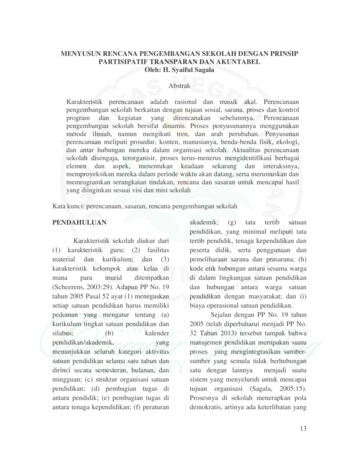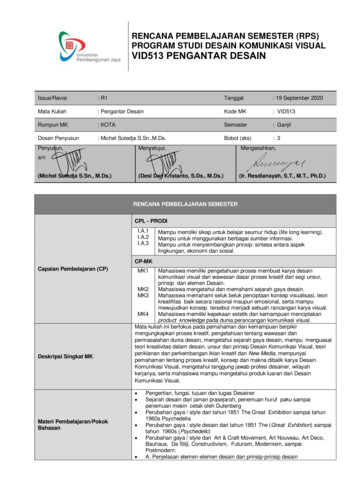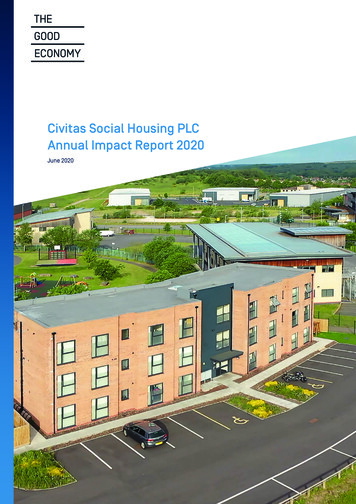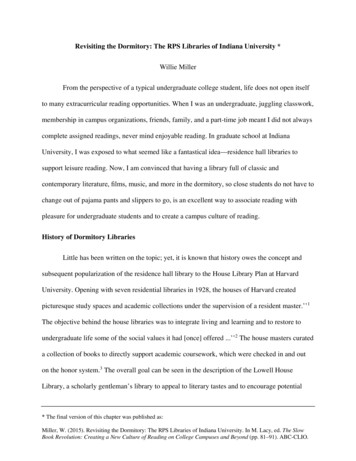
Transcription
Revisiting the Dormitory: The RPS Libraries of Indiana University *Willie MillerFrom the perspective of a typical undergraduate college student, life does not open itselfto many extracurricular reading opportunities. When I was an undergraduate, juggling classwork,membership in campus organizations, friends, family, and a part-time job meant I did not alwayscomplete assigned readings, never mind enjoyable reading. In graduate school at IndianaUniversity, I was exposed to what seemed like a fantastical idea—residence hall libraries tosupport leisure reading. Now, I am convinced that having a library full of classic andcontemporary literature, films, music, and more in the dormitory, so close students do not have tochange out of pajama pants and slippers to go, is an excellent way to associate reading withpleasure for undergraduate students and to create a campus culture of reading.History of Dormitory LibrariesLittle has been written on the topic; yet, it is known that history owes the concept andsubsequent popularization of the residence hall library to the House Library Plan at HarvardUniversity. Opening with seven residential libraries in 1928, the houses of Harvard createdpicturesque study spaces and academic collections under the supervision of a resident master.’’1The objective behind the house libraries was to integrate living and learning and to restore toundergraduate life some of the social values it had [once] offered .’’2 The house masters curateda collection of books to directly support academic coursework, which were checked in and outon the honor system.3 The overall goal can be seen in the description of the Lowell HouseLibrary, a scholarly gentleman’s library to appeal to literary tastes and to encourage potential* The final version of this chapter was published as:Miller, W. (2015). Revisiting the Dormitory: The RPS Libraries of Indiana University. In M. Lacy, ed. The SlowBook Revolution: Creating a New Culture of Reading on College Campuses and Beyond (pp. 81–91). ABC-CLIO.
bib-liophiles.’’4 Gradually, individual house libraries developed subject specialties. For example,some would cater more to students of the humanities, while others focused in the sciences.5Following the Harvard House Plan, many institutions experimented with the model ofresidence hall libraries. At the peak of the trend (roughly 1940–1960), there were more than 20residence hall library systems across North America. Among them were operations at HarvardUniversity, Stephens College, Yale University, Dartmouth University, Iowa State University,Michigan State University, Pennsylvania State University, Stanford University, SyracuseUniversity, Princeton University, University of Alberta, University of California at Los Angeles,University of Kansas, University of Michigan, University of Illinois at Urbana-Champaign, andIndiana University.6Residence hall libraries were difficult for institutions to operate for various reasons,including management, funding, and security.7, 8, 9 Edward Stanford found that oversight by theuniversity library system was essential to the success of a residence hall library; however, manysystems still struggled with the question of which unit should manage the residence libraries.10Along with the problem of management was the problem of sustainable funding. The creation ofa new library system required institutions to invest a considerable amount of money without aclear indication of the outcome.11 Finally, with Harvard’s model for circulation control operatingon the honor system amid limited staffing, many subsequent residence hall libraries failedbecause of theft. One librarian decried,Without regular staffing these [collections] were all looted and scattered indiscriminately. unless these [residence hall libraries] are set up as staffed and controlled collections. .it is not worth investing money in them . .’’122
By 1978, the number of active residence hall libraries funded and serving students hadshrunk to 12.13 In 2014, that number has further shriveled to two: University of Illinois atUrbana-Champaign and Indiana University. While residence halls at Stanford and Yale still offerlibraries in their lists of amenities, these facilities are not staffed, nor are their collections listedin the university catalog. Additionally, the University of Michigan maintained residence halllibraries until the 2003–2004 academic year, at which time they started converting some librariesinto community learning centers and deaccessioned or sold the contents of the others.14Opening in 1969, the residence hall libraries at the University of Illinois at UrbanaChampaign have had a successful history due to a full-time staff and institutional support. Thisprogram moved beyond the limits of the initial Harvard model and adapted to serve users withthe best methods possible. Nevertheless, this chapter will focus on the older and larger residencehall library system at Indiana University in Bloomington. As a graduate student in the IU Schoolof Library and Information Science, I worked in this system of residence hall libraries. Duringmy tenure, I worked at each location, starting as a student assistant, then a center supervisor, andeventually the assistant manager of libraries.Halls of Residence Libraries at Indiana UniversityThe Indiana University residence hall libraries have a long and complicated history,which is best chronicled by Barbara Brand Fischler15 and David A. Flynn.16 Susan AndrietteAriew17 and Gail Oltmanns and John H. Schuh18 also track the system’s journey and impact.When the first residence hall library opened what was then Men’s Residence Living Center (nowthe Collins Living-Learning Center) in February 1941, the residence hall libraries were a kind ofsouvenir brought back by the eleventh president of Indiana University, Herman B Wells, and thedirector of the halls of residence, Alice Nelson, from individual trips to the dormitory libraries at3
Harvard and Yale.19 Wells is noted as saying, “. if something was good enough for Yale orHarvard or Princeton, it might be good enough for us.’’20 The impetus of the Halls of ResidenceLibraries, as it would soon be called, was the thought that there is a positive educationaladvantage to leisure-time reading in student housing, and this would be beneficial to studentlearning and success.21 More than 70 years later, this foundational idea still supports the IUsystem of residence hall libraries.Funding the Halls of Residence Libraries initiated substantial cultural change at theuniversity. On October 1, 1940, the Halls of Residence Commit-tee voted to allow vendingmachines in the dormitories for the first time and to use a portion of the revenue to purchasebooks for the new libraries.22 By January 1, 1941, purchases from the new candy, peanut,cigarette, and Coca-Cola machines reached 505.05, enabling the new libraries to get off of theground.23 Collection development for the libraries was led by two committees of facultymembers and students who represented the residence hall population. Each residence hall createda list of suggested items, and the student representatives presented the lists to the committees forapproval.24 The first list of titles included Birds of America, Encyclopedia of Art, Physics MadeEasy, Book of Oriental Literature, Nine Plays, Origin of Species, and War and Peace.25 Thoughthe consensus was that the Halls of Residence Libraries should not be reference rooms foruniversity courses, the committees were concerned with stocking shelves with good’’ leisuretime reading . to develop the student’s desire to know good books.’’2As the Halls of Residence Libraries expanded both in number and collections, theconcept of good’’ materials would clash with students’ desires for recreational reading. When in1945 IU band director Gerald H. Doty was chosen to lead a committee to develop a musiccollection that would provide permanent value’’ to the residence hall libraries, he concluded this4
would eliminate all popular purchases from [the] fund.’’27 This struggle between good’’ or highcaliber items and popular items continued as the collection expanded into film. The Halls ofResidence Committee chose only films of an educational nature and not for recreational type ofentertainment.’’28The management of the Halls of Residence Libraries has been the responsibility of manyunits over the years. Starting with the Residence Halls Committee with a brief period ofcollaboration with the University Libraries, the system was also managed by the GraduateSchool and the dean of students. Mismanagement seriously bungled the system’s collectiondevelopment and infrastructure. Similar to other dormitory library systems, many items were lostand stolen from the libraries at IU.In 1959, the dean of undergraduate development, Samuel Braden, hired the first full-timeHRL librarian, Barbara Pratt.29 During her tenure, the legendary Pratt whipped the system intoshape. She started a tradition of hiring graduate Library and Information Science (LIS) studentsto manage each individual library. In addition, she opened new libraries and instituted a newcollection development plan—one that valued student interest a bit more than prestige. DorisKoch, Pratt’s long-time assistant, recalls, [We] saw a basic Rock n Roll collection listed in oneof the library journals and we bought the whole thing for each library. . . We sort of agonizedover whether to buy eight-tracks or cassettes. . . we chose the cassettes.’’30 This is a far cry fromthe planned music collection of 1945.Decreasing vending machine revenue accompanied by the allowance of low-watt minifridges in dorm rooms signaled a necessary change to the Halls of Residence Libraries.Following much discussion, the system’s management moved into the control of the UniversityLibraries in 1974, and funding was provided from a three-dollar activity fee added to tuition5
costs.31 In the hands of the University Libraries and under the direction of Carolyn TynanWalters, the system opened a family housing library and added the collection of 30,000 materialsto the online university catalog.32Move from IU Libraries to RPS and Current StructureIn 2001, Halls of Residence Libraries was moved under the control of IU ResidentialPrograms and Services (RPS).33 However, the new RPS Libraries maintained collaboration withthe University Libraries through sustained connection of the latter’s circulation and cataloginginfrastructure. At this time, six previous library spaces were converted into Music, Movies, andMore (3M) centers to complement the other six, more successful, residential libraries. Whenformer libraries were renovated into 3M centers, their monograph collections were added to theremaining libraries’ collections, and RPS leaders made sure that a full library was located inevery residence neighborhood on campus; therefore, residential students would always be withinwalking distance of an RPS library. Administratively, the system sits under the control of thedirector of residential life, and Manager of Academic Services Shawn Wilson, who holds amaster of library science degree, is the manager of libraries.In addition to Wilson, the RPS Libraries central office employs Library ServicesCoordinator Tina Walsh, an assistant manager of libraries, a part-time cataloger, and two studenttechnical assistants. Each of the 12 libraries and 3M centers has a center supervisor, usually agraduate student in library science, and a staff of five to seven student assistants. Locations areopen 5:00 p.m. until midnight, seven nights a week during the regular academic year. The systemis closed during school breaks, and only the Campus View (Family Housing) Library operatesduring the summer.6
In the 2012–2013 academic year, 111,450 users visited the libraries. This number isusually higher; however, one 3M was closed during the year for renovations. As of February2014, the Indiana University online catalog, IUCAT, showed RPS Libraries holdings of 49,700items. The system circulates books (reference, fiction, and nonfiction), music (CDs), films(DVDs & Blu-ray), and various video games, and all libraries offer a non-circulating collectionof popular newspapers and magazines. Student identification cards serve as library cards, andfines are connected to a student’s bursar account balance. With a staff of about 90 and 49 weeklyopen hours, the RPS Libraries system is similar to a small public library system.Popular CollectionsBeginning in 1949 with the construction of the Joseph A. Wright Quadrangle, every newresidence hall on the IU Bloomington campus had space for a library.34 In many dorms, WillkieResidence Center, for example, the library space is a beautiful and prominent feature of thearchitecture. Currently, every library has shelving adequate to hold roughly 6,000 materials(books, DVDs, CDs, newspapers, and magazines), study tables and chairs, soft seating, and acirculation desk. The 3M centers are smaller spaces that are not designed for study. The librariesand 3M centers are near enough to residence hall computer labs that most do not have computersavailable for users.The residence hall libraries of Indiana University, Bloomington were established as asource of good leisure reading and reference materials.’’35 During its history, good leisurereading’’ has had many meanings. In 1941, it seemed to mean of lasting educational value.’’Seventy-three years later, more worth is placed on the value of pleasurable, popular, and/orculturally significant materials. Indeed, the times have changed, and films need not be purelyeducational—both entertainment and cultural impact are considered important.7
After a study of students’ use and perceptions of the residence hall libraries, IU librarianGail Oltmanns and Associate Dean of Students John H. Schuh found data to suggest collectionsof this type should be developed more to meet the recreational reading needs of students.36Oltmanns and Schuh conclude successful residence hall libraries should meet the general publiclibrary needs of students who live in residence, and that academic needs can be met by. . thecampus library system.’’37 The current mission of RPS Libraries is to provide residents withlibrary collections, programs, and services that support their academic, cultural, and recreationalneeds.’’38 It is perhaps the support of recreational needs that is most responsible for thecontinued success of the system.The direction of the collection development in the RPS Libraries has tilted into thedirection of popular materials since at least the Pratt era. This is reasonable since the system ismotivated by use: from 1974 to present, residential student activity fees have funded the system,and low door counts would signal its obsolescence. By filling a gap in the collections of the mainuniversity library system and being more convenient than the local public library to residentialstudents, the RPS Libraries niche of popular items ensures its success. Many a graduate studentand faculty member has been saddened to learn that all of the university’s copies of, say, MeanGirls are owned by RPS Libraries and are available only to residents of the residence halls,though the system will allow a professor to check out materials for class under specialpermission. Even at a time when Redbox, Netflix, iTunes, Kindles, and illegal downloading areubiquitous, the RPS libraries are as busy as ever.This is not to say the collections of the RPS Libraries are trivial in nature. The holdingsof the system include reference books, classic literature, award-winning films, and music. In thevery early years, it would have been unlikely for contemporary literature to be purchased;8
however, current collection development relies on sources like the New York Times, Amazon,and iTunes for their bestseller’s lists. Residence hall libraries previously contained reserves forcourses, but this service is no longer provided. It likely ended after Oltmanns and Schuh’s studyon the use of the libraries. The system relieved itself of most services that competed against theuniversity libraries’ expertise, though it should not be said that the RPS Libraries directlycompetes with the local public library, and the Monroe County Public Library remains a verysuccessful library system. Further, staff encourage users to patronize the public library if theycannot find desired items within the RPS Libraries holdings. In this way, the system helps inspirestudents to use the public library and to build a habit of library use for life.As previously mentioned, monographic purchase decisions take into account resourcessuch as the New York Times and Amazon’s bestseller lists. The libraries aim to offer books thatare popular in contemporary culture, in addition to literary classics and genre fiction. In this way,the collections are similar to browsing collections,’’ which are becoming a trend in traditionalacademic libraries.39 Broadening into public library territory, staff members of the RPS Librariesprovide readers’ and/or viewers’ advisory services. Moreover, locations most often feature a staffpicks’’ display with book, movie, or album reviews written by student assistants and centersupervisors.Embedded LibrarianshipThough there is a considerable amount of overlap, each library’s collection maintains apersonality of its own, largely based on each dormitory’s student population. For example, theCampus View (Family Housing) Library serves more international students than average and asa result, its collection has a significant number of international and foreign language items.Additionally, as it serves families, the Campus View Library is the only RPS library with9
children’s books. The Collins Library is known for its collection of graphic novels and zines, asthe students of the Collins Living-Learning Center are known for their creative and artistictalents.Moreover, in most cases, a residence hall’s student government makes special donationsto the library or 3M to expand its collection to include materials of educational or culturalsignificance to students in residence. In 2009, the students of Eigenmann Residence Center gavesuch a donation to start a collection of books on the topic of sustainability. The center supervisornot only purchased materials in the area but also collaborated with student organizations todevelop programs on the topic of environmental sustainability in the library.Collaboration with the residence hall is important to the staff of the RPS Libraries. Themove in management from the University Libraries to Residential Programs and Services seemsto have added powerful motivation to work with residence hall staff and student organizations.Center supervisors sit on the community boards of the residence centers and often collaboratewith center constituents to provide relevant, cohesive programming. The library system iscompletely embedded in the residence hall, and it is successful as a result of the full support ofthe residential life unit.In addition, each month, center supervisors are required to develop an out-reach program.RPS Libraries management encourages partnerships with campus or residence hall organizations.Monthly programs usually highlight a part of the location’s collection, and they haveeducational, cultural, and/or recreational learning outcomes. Some past programs include BannedBooks, Hispanic History, and Love & Murder (Valentine’s Day). A successful program RPSlibraries have offered is one in which a user reads a certain number of books from the collectionor possibly even from a specific genre. After completing the readings, the user receives a candy10
bar. This kind of programming helps build a more robust culture of reading on campus andcreates a community of readers within the residence hall. Further, possibly nostalgic of primaryschool, users of the RPS Libraries respond well to programs with a crafting component, andaccordingly, many programs feature craft projects like creating hand turkeys, coloring, andorigami. Most RPS Libraries staff believe the crafting programs are playful pastimes to helpstudents relax from coursework.The Potential of Residence Hall LibrariesRecent literature on libraries and residence halls highlights successful instances ofacademic library outreach in residence centers, with notable programs at Purdue University andthe University of Oklahoma.40, 41, 42 Moreover, some chapters of this book detail the developmentand triumph of small com-munity lending libraries in residence halls. These initiatives aresignificant and should be esteemed; however, it is my belief that these are only small stepstoward a far away goal. If the literature is true, and academic librarians want students,particularly undergraduate students, to engage in more pleasure reading, then academic librariesneed to reconsider the residence hall library in the model of Indiana University or the Universityof Illinois at Urbana-Champaign.The trend of popular browsing collections at academic libraries is surging. Academiclibrarians are asserting the importance of leisure reading collections, which include popular titlesstudents would want to read for pleasure.43 This trend is partially steeped in the belief thatstudents will be attracted to the popular items and will perhaps also peruse more of the library’scollection.44 However, a major obstacle to this movement is the cadre of academic librarians whofear popular browsing areas will somehow make academic libraries appear less academic andmore like a public library.45 Creating a residence hall branch library and relocating a potential11
popular browsing collection to that space could be a solution to assuage concerns and increasestudent engagement with the main campus library.Students are more likely to engage in pleasure reading when engaged in an academicsetting.46 For recreation, they are more likely to use visual media than books.47 The RPS librarymodel for collections, which feature books, movies, music, and more, capitalizes not only on themedia preferences of undergraduate students it also creates an environment conducive topleasure reading. A common display at an RPS library will center on a popular movie ortelevision series. The message will advertise, Do you like the Twilight films? You might alsoenjoy the Twilight series of books. Or Buffy the Vampire Slayer. Or Bram Stoker’s Dracula. Orbooks by Anne Rice. Or the latest album by Vampire Weekend.’’ All of the suggested itemswould be on display and available, and based on my experience, most of the items would becirculated. This kind of readers’ and viewers’ advisory is uncomfortable for many academiclibrarians,48 but it does feel natural in a residence hall library.If an institution were to create a new residence hall library, it would be important tocollaborate with the director of residence life. The university library and the office of studentaffairs could negotiate a funding structure. The idea could be proposed as a joint initiative toincrease retention and academic success. The expertise in the academic library’s circulation andsecurity infrastructure would be essential to protect the investment in the collection. As apotential branch of the main library system, such a library could feature some small referenceservices and guides. In addition to print books, a residence hall library would do well to includepopular eBooks.Furthermore, it seems imperative for residence hall libraries to be open late night andweekend hours. The most active time for an RPS library is Friday night, when more than 10012
students enter the doors in search of a productive way to relax. Both IU and UIUC have successemploying trained student workers to staff the libraries during open hours.Though a residence hall library is not the answer for every institution, it would likelywork on many campuses. The 86–year-old idea to encourage potential bibliophiles’’49 is still agood one, though its initial conception was flawed. The flaws included poor security,mismanagement, and spotty, uninteresting collections. The final flaw was a tragic result of theresidence hall library attempting to compete with the main academic library. Competition fordominance in academic collections, course reserves, and reference will never and has never beenthe appropriate fight for the residence hall library. On the other hand, the residence hall librarycan extraordinarily provide a niche collection in popular titles to support or augment a student’sacademic, cultural, and recreational needs. Instead of competing with the public library, it bringsthe public library to a demographic that traditionally does not use it or read for pleasure.13
Notes1. Kenneth Morgan, The Harvard House Libraries.’’ Library Journal 56, no. 6 (June 15 1931):536–539.2. Frank N. Jones, The Libraries of the Harvard Houses.’’ Harvard Library Bulletin 2 (Autumn1948), 362.3. Susan Andriette Ariew, The Failure of the Open Access Residence Hall Library,’’ Collegeand Research Libraries 39, no. 5 (1978): 372–380, http://crl.acrl.org/content/39/5/372.full.pdf html.4. Frank N. Jones, The Libraries of the Harvard Houses,’’ Harvard Library Bulletin 2 (Autumn1948), 363.5. Edward B. Stanford, Residence Hall Libraries and Their Educational Potential,’’ College andResearch Libraries 30, no. 3 (1969), 198, http://crl.acrl.org/content/30/3/197.full.pdf html.6. Ariew, The Failure of the Open Access Residence Hall Library,’’ 373–374.7.Stanford, Residence Hall Libraries and Their Educational Potential,’’ 197–203.8.Ariew, The Failure of the Open Access Residence Hall Library,’’ 372–380.9.Gail V. Oltmanns and John H Schuh, Purposes and Uses of Residence Hall Libraries,’’College & Research Libraries 46, no. 2 (1985): l.pdf html.10.Stanford, Residence Hall Libraries and Their Educational Potential,’’ 197–203.11.Ibid., 201.12.Ibid., 202.14
13.Andriette Ariew, The Failure of the Open Access Residence Hall Library,’’ 374.14. Eleanor Fye, Ke Lu, and Jennifer Sharp. Finding Aid for Residence Hall Libraries(University of Michigan) Records, 1954–2005.’’ University of Michigan Archives, last modifiedNovember 2013, accessed February 24, 2014, rgn main;view text.15. Barbara Brand Fischler, An Analysis of the Use of the Undergraduate Halls of ResidenceLibraries at Indiana University’’ (master’s thesis, Indiana University, 1964), 1–34.16. David A. Flynn, There’s No Place Like Home: A History of the Halls of Residence Librariesat Indiana University, Bloomington.’’ Indiana Libraries 12, no. 1 (1993): 2–10.17.Ariew, The Failure of the Open Access Residence Hall Library,’’ 372–380.18.Oltmanns and Schuh. Purposes and Uses of Residence Hall Libraries,’’ 172–177.19.Fischler, An Analysis of the Use of the Undergraduate Halls of Residence Libraries atIndiana University,’’ 1.20.Flynn, There’s No Place Like Home,’’ 2.21.Ibid.22.Fischler, An Analysis of the Use of the Undergraduate Halls of Residence Libraries atIndiana University,’’ 2.23. HRL Archives, Halls of Residence Libraries Committee Report,’’ Bloomington: IndianaUniversity, Bloomington, 1941.15
24. Fischler, An Analysis of the Use of the Undergraduate Halls of Residence Libraries atIndiana University,’’ 2.25.Flynn, There’s No Place Like Home,’’ 3.26.HRL Archives, Halls of Residence Libraries Committee Report.’’27.Gerald H. Doty, Letter to Robert Irrmann,’’ Bloomington: Indiana University HRLArchives, 1945.28.Flynn, There’s No Place Like Home,’’ 5.29.Ibid., 7.30.Ibid.31.Ibid., 8.32.Ibid., 9.33.Rebecca Smith, Indiana University Halls of Residence Libraries Records, 1940–2001,Bulk 1950–1970.’’ Indiana University Archives, accessed February 10, view?doc.view entire text&docId InU-ArVAC0939.34.Flynn, There’s No Place Like Home,’’ 4.35.Fischler, An Analysis of the Use of the Undergraduate Halls of Residence Libraries atIndiana University,’’ 2.36.Oltmanns and Schuh. Purposes and Uses of Residence Hall Libraries,’’ 172–177.37.Ibid., 176.16
38.Shawn Wilson, email message to author, February 18, 2014.39.Pauline Dewan, Why Your Academic Library Needs a Popular Reading Collection NowMore Than Ever,’’ College & Undergraduate Libraries 17, no. 1 (2010): 44–64.40.Phyllis Rudin, No Fixed Address: The Evolution of Outreach Library Services onUniversity Campuses,’’ Reference Librarian 49, no. 1 (2008): 55–75.41.Catherine Fraser Riehle and Michael C. Witt. Librarians in the Hall: InstructionalOutreach in Campus Residences,’’ College & Undergraduate Libraries 16, no. 2/3 (2009): 107–121.42.Molly Strothmann and Karen Antell, The Live-In Librarian: Developing LibraryOutreach to University Residence Halls,’’ Reference & User Services Quarterly 50, no. 1 (Fall2010): 48–58.43.Dewan, Why Your Academic Library Needs a Popular Reading Collection Now MoreThan Ever,’’ 44–64.44.Tom Kirk, What Has Happened to Browsing Collections in Academic Libraries?’’Library Issues 30, no. 5 (2011), 2.45.Julie Elliott, Academic Libraries and Extracurricular Reading Promotion,’’ Reference &User Services Quarterly 46, no. 3 (2007), 39.46.Anne Salter and Judith Brook, Are We Becoming an Aliterate Society? The Demand forRecreational Reading among Undergraduates at Two Universities,’’ College & UndergraduateLibraries 14, no. 3 (2007): 27–43.47.Ibid.17
48.Julie Elliott, Barriers to Extracurricular Reading Promotion in Academic Libraries,’’Reference & User Services Quarterly 48, no. 4 (2009): 340–346.49.Frank N. Jones, The Libraries of the Harvard Houses.’’ Harvard Library Bulletin 2(Autumn 1948), 362.18
Miller, W. (2015). Revisiting the Dormitory: The RPSLibraries of Indiana University. In M. Lacy, ed. The Slow Book Revolution: Creating a New Culture of Reading on College Campuses and Beyond (pp. 81-91). ABC-CLIO. Revisiting the Dormitory: The RPS Libraries of Indiana University * Willie Miller


